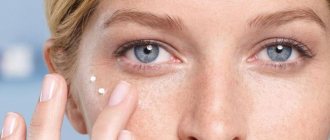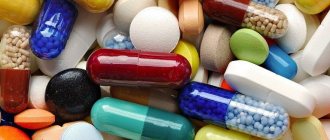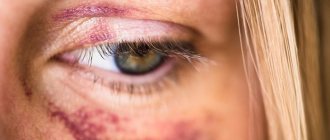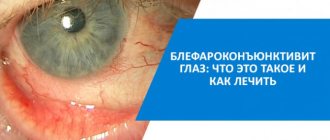Quincke's edema is an acute condition of swelling of the skin, mucous membranes and subcutaneous fat, which is the result of an allergic reaction accompanied by increased production of histamine and inflammation of the blood vessels.
Most often, symptoms of Quincke's edema in adults appear on the face, spreading to the mucous membrane of the pharynx and larynx. Internal organs, meninges, and joints may also be affected.
Swelling develops extremely quickly and is considered an emergency condition that requires immediate medical attention.
What it is?
Quincke's edema (angioedema, giant urticaria, trophoneurotic edema, angioedema) is a suddenly developing acute allergic reaction of the body, characterized by massive swelling of the mucous membranes, skin and subcutaneous fat.
Quincke's edema typically develops on the neck, upper torso, face, and back of the feet and/or hands. Much less often it affects internal organs, joints and membranes of the brain.
This pathological manifestation can develop in absolutely any person, but most often occurs in young women and children.
Causes
Quincke's edema can be allergic and pseudo-allergic.
Allergic Quincke's edema appears upon contact with an allergen. For an allergic reaction to develop, the body must already be sensitized - there has already been an encounter with the allergen, and the body has developed antibodies. When this allergen re-enters the site of contact, inflammation is caused: small vessels dilate, their permeability increases, and as a result, tissue swelling occurs.
Allergens can be:
- Pollen.
- Various insect bites.
- Wool and animal waste products.
- Cosmetics.
- Food products (citrus fruits, chocolate, eggs, fish products, various berries).
- Medications. The most common reaction is to antibiotics, painkillers, and vaccines. The reaction can range up to anaphylactic shock, especially if the drug is administered by injection. Vitamins and oral contraceptives rarely cause anaphylactic shock.
Pseudoallergic edema is a hereditary disease; patients have a pathology of the complement system. This system is responsible for triggering an allergic reaction. Normally, the reaction starts only when an allergen enters the body. And with pathology of the complement system, activation of inflammation also occurs from thermal or chemical exposure, in response to stress.
Classification
There are several classifications of joint stock companies, each of which is based on one criterion. Thus, according to the course, the disease is divided into acute (lasting less than 6 weeks) and chronic (over 6 weeks). Based on the presence of urticaria during an attack - into combined (with rashes, itching, etc.) and isolated angioedema.
However, the most complete classification is considered to be based on the mechanism of occurrence:
- hereditary angioedema associated with genetically determined and dysregulation of the complement system - a complex of substances directly responsible for allergies;
- acquired angioedema, in which dysregulation of the complementary system is acquired due to immune disorders, infections, lymphoproliferative diseases;
- angioedema caused by long-term use of one of the categories of antihypertensive drugs - ACE inhibitors;
- swelling caused by hypersensitivity to certain substances - medications, foods, insect poison, etc.;
- swelling associated with infections of various organs;
- Quincke's edema caused by autoimmune diseases.
The most common are 2 forms of angioedema - hereditary and allergic:
Kinds
Depending on the duration of the pathological process, acute and chronic angioedema are distinguished. The transition of the condition to a chronic form is indicated by its duration of more than 1.5 months.
Angioedema can be combined with urticaria or be isolated.
Based on the characteristics of the development mechanism, hereditary and acquired types of angioedema are distinguished. The acquired ones, in turn, are divided as follows:
- allergic;
- pseudoallergic;
- associated with the use of ACE inhibitors;
- associated with autoimmune processes and infectious diseases.
In 50% of cases, allergic and pseudoallergic angioedema is accompanied by the development of urticaria and anaphylactic shock.
There is also an idiopathic form. They talk about it when it is not possible to establish the cause of the pathological permeability of the vascular wall.
Causes of Quincke's edema
Allergic edema based on an allergic antigen-antibody reaction. Biologically active substances - mediators (histamine, kinins, prostaglandins) released in a previously sensitized body cause local dilation of capillaries and veins, an increase in microvascular permeability occurs and tissue edema develops. The cause of allergic edema may be exposure to specific foods (eggs, fish, chocolate, nuts, berries, citrus fruits, milk), medications and other allergens (flowers, animals, insect bites).
In patients with non-allergic Quincke's edema, the disease is caused by heredity. Inheritance occurs according to the dominant type. The level of C-esterase inhibitors and kallikrein was reduced in the serum of patients. In this case, angioedema, similar to allergic edema, develops under the influence of substances that cause the formation of histamine - the same allergens. Edema develops in a sensitized body under the influence of specific allergens: flowers, animals, food, drugs, cosmetics or nonspecific: stress, intoxication, infections, hypothermia.
Predisposing factors may be diseases of the liver, thyroid gland (especially with its reduced function), stomach, blood diseases, autoimmune and parasitic diseases. Often in this case the disease takes on a chronic relapsing course.
In some cases, the cause of Quincke's edema cannot be determined (so-called idiopathic edema).
Causes of pathology
The main reason for the development of the angioedema process is a distorted reaction of the body to its own protein.
In this case, the immune bodies come into conflict with their own tissues and begin to fight them, as would happen with foreign elements. Angioedema is divided into two types :
- The acquired type is idiopathic , which appears as a result of severe allergies to various substances, injuries of various types, helminthic infestations, severe stress and depression, and concomitant severe chronic diseases. A significant portion of allergies occur as a response to exposure to cold, frostbite, sun rays on the beach and artificial ultraviolet radiation in solariums.
- The congenital form has a hereditary basis and is expressed in changes in certain genes and their fragments.
The disease is divided precisely on the basis of the differences in factors that potentiate the appearance, development and exacerbation of the pathology. What these two types have in common is a syndrome of dysfunction of the immune system, manifested by an excessive reaction to a certain list of foreign substances.
Related article:
Treatment of eczema - is complete recovery possible?
Quincke's edema - photo gallery
angioedema
angioedema
angioedema
angioedema
Quite often, even modern diagnostic techniques and techniques and a comprehensive examination using specific tests do not allow us to identify the exact cause of Quincke's edema. This situation poses a particular danger to the patient. No one around him has any idea when and why the next attack will occur.
Symptoms and first signs
The main and very first symptoms of Quincke's edema in children and adults are the occurrence of edema in places with developed subcutaneous tissue - on the lips, eyelids, cheeks, and oral mucosa.
The color of the skin does not change. There is no itching. In typical cases, it disappears without a trace after a few hours (up to 2-3 days). The swelling may spread to the lining of the larynx, which can cause difficulty breathing. In this case, there is a hoarseness of the voice, a barking cough, difficulty breathing (first exhale, then inhale), noisy breathing, the face is hyperemic, then suddenly turns pale. Hypercapnic coma occurs and then death may occur. Nausea, vomiting, abdominal pain, and increased peristalsis are also noted.
Angioedema differs from ordinary urticaria only in the depth of skin damage. It should be noted that manifestations of urticaria and angioedema may occur simultaneously or alternate.
Complications
Consequences that pose a threat to life are edema, which affects the mucous membrane of the larynx with an increase in suffocation associated with acute respiratory failure, as well as swelling of the meninges with symptoms of meningitis. The listed complications in most cases lead to the death of the patient.
With angioedema, regardless of its location, anaphylactic shock often develops - an extremely complex and life-threatening reaction that affects the functioning of the entire body. Its main manifestations:
- swelling of the oropharynx, larynx and tongue;
- generalized itching;
- hives;
- bronchospasm, lacrimation;
- nausea, vomiting, abdominal pain, diarrhea;
- tachycardia, hypotension, arrhythmia, acute heart failure;
- convulsions, asphyxia, coma.
Fatal complications, namely death, are caused by illiterate therapeutic actions on the part of others and ambulance specialists.
First aid for Quincke's edema
In this part we will talk about self- and mutual help:
- The first step that should be taken when Quincke's edema develops is to call an ambulance. If the ambulance obviously doesn’t arrive, it would be faster to take or drag the patient to the nearest medical facility - drag it, having first completed step two or three.
- Give an antihistamine (fenkarol, diazolin, diphenhydramine). Injectable forms of antihistamines are more effective, since it is possible that swelling of the gastrointestinal tract develops and the absorption of substances is impaired. In any case, you need to take 1 - 2 tablets of the drug if it is not possible to get an injection. The medicine will weaken the reaction and alleviate the condition until the ambulance arrives.
- In the absence of antihistamines or other allergy medications, pour banal naphthyzine (nasal drops) into the mouth of an adult or teenager in a dosage of 2-3 drops or drip into the nose
- We calm the patient, open the windows, free the neck and chest from constricting clothing, remove jewelry (chains, earrings, etc.). We take the child in our arms, we don’t scream or become hysterical.
- If the allergen is known, we remove it if possible.
- Apply cold to the site of swelling.
- If a person has lost consciousness, we perform artificial respiration.
- Relatives of patients with recurrent edema usually know about Prednisolone and are able to independently administer this drug intramuscularly.
Remember that a person’s life may depend on coordinated and reasonable actions from the first minutes of the development of Quincke’s edema.
How to treat the disease?
In order to alleviate the patient's condition, a cold compress should be placed on the swollen area.
It is also necessary to put drops into the nose to narrow the blood vessels.
You can give a tablet of a drug with an antiallergic effect. In addition, it is necessary to ensure that fresh air enters the room where the patient is located.
If a child is bitten by an insect, then it is necessary to remove the sting from the affected area, and then apply a tourniquet above this area for 25 minutes.
It is imperative to call a doctor.
Conducting a survey
To develop the most effective treatment regimens for Quincke's disease, it is necessary to find an individual approach to each patient. Here, observation and diagnosis of the patient, as well as his examination, are of great importance. Only after all these measures have been carried out, it is necessary to prescribe treatment to eliminate all causes of the disease. It is forbidden to self-medicate, as this will not give the desired result, but will only worsen the patient’s condition. To quickly cure angioedema, you need to contact qualified specialists. If treatment is prescribed on time, this will alleviate the patient’s condition and speed up his recovery.
Step-by-step treatment
If the patient has mild edema , then in this case treatment is limited to taking antihistamines, which can be purchased at any pharmacy without presenting a prescription. You can also use alternative methods to treat this disease. Taking these medications to patients will help them get rid of the symptoms of the disease within a few days.
If the swelling is severe, then the main goal is to restore breathing. After this, it is necessary to reduce the symptoms. In this case, identifying the allergen that caused swelling in the patient is of great importance. When the cause of the patient's edema is established, you can proceed to treatment, which should prevent further spread of edema and reduce the existing one.
In this case, treatment involves avoiding contact with the allergen, as well as prescribing and taking appropriate medications. In order to reduce histamine levels, tavegil, suprastin, and veritin are prescribed.
In order to reduce parasympathetic activity , atropine is prescribed.
To reduce vascular permeability, the patient is prescribed vitamin therapy, and the drug ascorutin is also prescribed.
Systemic corticosteroids are prescribed for desensitization. They provide increased production of missing C1 inhibitors if the patient’s susceptibility to allergies is a hereditary trait.
Also during treatment, calcium, ascorbic acid, and ephedrine are prescribed.
For quick healing, a hypoallergenic diet is prescribed, which excludes foods that can cause an allergic reaction. Enzyme preparations are also prescribed - Creon, Festal.
Treatment of infections - intestinal diseases, caries, ARVI.
Carry out preventive measures, which are of great importance in the treatment of the patient.
Emergency care for Quincke's edema
Here comes the time for qualified medical care from an ambulance or hospital or clinic personnel:
- Stopping contact with the allergen;
- Quincke's edema against the background of low blood pressure requires the subcutaneous administration of a 0.1% solution of adrenaline in a dose of 0.1-0.5 ml;
- Glucocorticoids (prednisolone hymisuccinate 60-90 mg administered intravenously or intramuscularly or dexamethasone 8 to 12 mg intravenously);
- Antihistamines: suprastin 1-2 ml or clemastine (tavegil) 2 ml intravenously or intramuscularly.
For swelling of the larynx:
- Stopping exposure to the allergen;
- Oxygen inhalation;
- Saline solution 250 ml intravenous drip;
- Adrenaline (epinephrine) 0.1%-0.5 ml intravenously;
- Prednisolone 120 mg or dexamethasone 16 mg intravenously;
- If measures are ineffective, tracheal intubation is performed. Before this: atropine sulfate 0.1%-0.5-1 ml intravenously, midazolam (dormicum) 1 ml or diazepam (relanium) 2 ml intravenously, ketamine 1 mg per kg of body weight intravenously;
- Sanitation of the upper respiratory tract;
- A single attempt at tracheal intubation. If ineffective or impossible to perform, conicotomy (dissection of the ligament between the cricoid and thyroid cartilages), artificial ventilation;
- Hospitalization.
In the absence of laryngeal edema, hospitalization is indicated for the following groups of patients:
- children;
- if Quincke's edema has developed for the first time;
- severe Quincke's edema;
- swelling due to medication;
- patients with severe cardiovascular and respiratory pathologies;
- persons who were vaccinated with any vaccine the day before;
- have recently had an acute respiratory viral infection, stroke or heart attack.
Treatment at home
Treatment of Quincke's edema outside the acute stage at home includes:
- Complete exclusion of the patient’s contact with an identified allergen if the cause of the swelling develops as an allergic reaction with symptoms of urticaria.
- Short courses of hormones that temporarily “block” the reactions of the immune system, Prednisolone, Dexazone, Dexamethasone. Prednisolone. For adults - up to 300 mg, for newborns the dose is calculated according to the formula 2 - 3 mg per kg of baby's body weight, for children over one year old and schoolchildren from 7 years old at the same dosage. Dexamethasone for adults - 60 - 80 mg, for small patients - in a strictly calculated dosage by weight: 0.02776 - 0.16665 mg per kilogram.
- Preparations to strengthen the nervous system (calcium, ascorbic acid).
- Vitamin complexes, Ascorutin to reduce vascular permeability, gammaglobulins.
- The use of histamine H1 receptor blockers (antiallergic) to reduce sensitivity to the allergen and block further histamine production. In the initial period, Suprastin, Diphenhydramine, Pipolfen, Tavegil are used intramuscularly, switching to the use of antiallergic drugs in tablets Zyrtec, Ketotifen, Terfenadine, Astemizole, Fexofenadine, Loratadine, Acrivastine, Cetirizine.
Wherein:
- Suprastin: adults on average 40 – 60 mg, taking into account that the dose per kilogram of body weight cannot be higher than 2 mg. Children: 1 – 12 months: 5 mg; from 12 months to 6 years: 10 mg; from 6 to 14: 10 – 20 mg.
- Ketotifen (except for pregnant women) is indicated as an effective antiallergic agent for a combination of edema and bronchospasm, which often occurs with edema in patients with asthma or obstruction (obstruction) of the respiratory tract. Adults 1 – 2 mg 2 in the morning and evening. Children over 3 years old - 1 mg (5 ml syrup); from six months to 3 years - 0.5 mg (2.5 ml) morning and evening. Treatment is carried out for 2 – 4 months.
For swelling against the background of itchy rashes and blisters, additionally use:
- Ranitidine, Cimetidine, Famotidine are drugs that suppress histamine H2 receptors;
- so-called calcium channel blockers (20 – 60 mg of Nifedipine per day);
- leukotriene receptor antagonists (Montelukast, 10 mg per day).
There are significant differences in the treatment of hereditary angioedema from the standard treatment regimen for angioedema. Corticosteroids and antiallergic drugs are completely useless; they will not help the patient, and improper treatment of undiagnosed angioedema of hereditary origin most often leads to the death of the patient.
The main assistance is aimed at replenishing the deficiency and enhancing the production of C-1 inhibitor. In most cases they use:
- plasma infusion;
- intravenous administration of tranexamic or aminocaproic acid;
- Danazol in a daily dosage of 800 mg, Stanozolol 12 mg;
- for long-term prevention, e-aminocaproic acid is prescribed in a daily dose of 1–4 grams with regular monitoring of blood clotting (twice a month). Danazol 100 – 600 mg per day.
Treatment
Therapeutic measures aimed at combating angioedema include two stages: stopping the acute pathological process and eliminating its causes. After emergency assistance is provided, the patient is sent to the hospital.
The choice of department is determined by the severity of the disease. In a complex condition, for example, with swelling of the larynx, the patient is taken to intensive care. In case of abdominal syndrome, the patient is hospitalized in the surgical ward. If there is no threat to life, then the victim is sent to the therapeutic or allergy department.
The treatment process directly depends on the nature of the disease. A prerequisite is the complete exclusion of the patient’s contact with the allergen; for this, specialists reliably identify to which product or substance a person has individual hypersensitivity.
At the time of therapeutic measures, a hypoallergenic diet is prescribed, excluding honey, berries, chocolate and other products that can become potential irritants.
The patient is prescribed antihistamines - Suprastin, Citrine, etc. As a rule, the course of taking them is from 7 to 10 days.
For a short period, the patient is recommended to undergo hormone therapy, which includes Prednisolone and or Dexamethasone - no more than 5 days. To evacuate the allergen from the body - Polysorb or Enterosgel in a three-day course.
Diet and nutrition
The diet for Quincke's edema is developed taking into account several fundamental principles:
- When developing a dietary menu for a patient with angioedema, it is necessary to be guided by the principle of elimination. In other words, it is necessary to exclude from the patient’s menu foods that can cause a direct or cross allergic reaction. The diet menu should not contain foods high in amines, including histamine, or foods with high sensitizing properties. Products should, whenever possible, be natural and not contain synthetic food additives.
- The nutritional diet must be carefully thought out, and products excluded from it must be correctly replaced. This will allow you to optimally adjust the qualitative and quantitative composition of the menu.
- The third principle is the principle of “functionality”. Products should be beneficial and help maintain and improve health.
If you follow the advice and rules of therapeutic nutrition, positive dynamics will be observed. However, diet therapy becomes the most necessary, relevant and effective measure in cases where a certain food product acts as an allergen.
The most common foods that can cause “true” and pseudoallergic reactions:
- Fish and seafood, chicken and eggs, soy, milk, cocoa, and peanuts often cause true allergic reactions. Of the plant foods, the most allergenic are tomatoes, spinach, bananas, grapes and strawberries.
- Pseudoallergic reactions can be caused by the same foods as true allergies. You can add chocolate, spices, and pineapple to the list.
- With caution, you should include foods containing biogenic amines and histamine in your menu. These are fish (cod, herring, tuna) and shellfish, cheese, eggs, spinach, rhubarb, tomatoes, sauerkraut. People with allergies should avoid wine.
- You need to exclude from the menu products that contain nitrogen-containing extractive compounds. These are legumes (lentils, beans, peas), black tea, coffee and cocoa, broths, stewed and fried meat and fish dishes.
Synthetic food additives often cause the development of allergies and swelling. Among them are preservatives (sulfites, nitrites, benzoic acid and its derivatives, etc.) and dyes (tartrazine, amaranth, azorubine, erythrosine, etc.), flavorings (menthol, vanilla, cloves and cinnamon, glutamates) and taste stabilizers.
Diet
A person who has had angioedema once must subsequently adhere to strict nutritional rules. Failure to comply with them may cause a relapse of the disease.
Immediately after an attack, the following foods are prohibited:
- chocolate;
- honey;
- eggs;
- citruses;
- nuts;
- products saturated with chemical fillers: dyes, flavors;
- cow's milk;
- red and orange fruits and berries;
- coffee;
- canned food
Allowed to include in the diet:
- low-fat fermented milk products;
- porridge with water;
- vegetarian soups;
- bread with bran.
In the first days after Quincke's edema, doctors insist on a starvation diet. New products are being introduced gradually.
Complications and consequences
As mentioned above, the most dangerous complication of angioedema affecting the larynx or trachea is asphyxia, leading to coma and, possibly, disability or death.
If the edema is localized in the gastrointestinal tract, then a complication in the form of peritonitis is possible, and increased intestinal motility and dyspeptic disorders may also be observed. In case of damage to the urogenital system, the complication can manifest itself through symptoms of acute cystitis and the development of urinary retention.
The greatest concern is caused by swelling on the face, because if they are present, there is a possibility of damage to the brain or its membranes, accompanied by the appearance of labyrinthine systems and meningeal symptoms - all of which pose a direct threat to life.
Prevention and prognosis
The outcome of Quincke's pathology will depend on the degree of edema and the timeliness of emergency care. For example, in case of an allergic reaction in the larynx, in the absence of prompt therapeutic action, the outcome can be fatal. If the disease is recurrent and accompanied by urticaria for six months, then in 40% of patients the pathology will be observed for another 10 years, and in 50% a long-term remission occurs even without preventive treatment. The hereditary type of angioedema will recur throughout life.
Correctly selected preventive and supportive treatment will help to avoid relapse, which significantly reduces the likelihood of developing pathology or complications. Measures to prevent Quincke's reaction depend on the type of pathology:
- If there is a history of allergic genesis, then it is important to follow a diet and exclude potentially dangerous medications.
- If it is possible to recognize hereditary angioedema, then viral infections, injuries, taking ACE inhibitors, stressful situations, and estrogen-containing medications should be avoided.
Urticaria Pancreatitis Lyme disease (tick-borne borreliosis): symptoms, treatment, photo Hepatitis C: first signs and treatment regimen Bradycardia: symptoms and treatment Staphylococcus aureus
Prevention
Following certain rules will help prevent the development of soft tissue swelling:
- eat right;
- If you are prone to allergies, follow a gentle diet;
- take vitamin complexes to strengthen the immune system;
- avoid contact with foods and medications that cause allergies;
- If you have allergic reactions to certain types of medications, be sure to notify your doctor;
- When taking a new type of antibiotic, keep antihistamines on hand.









